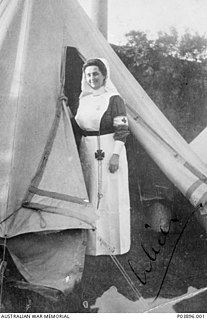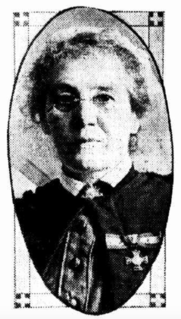 W
WLydia Abell was a civilian and military Australian nurse. She served in World War I and received the Royal Red Cross for bravery during the evacuation of a field hospital that was under enemy bombardment on the Western Front.
 W
WAlice Elizabeth Barrett Kitchin was an Australian nurse who served in World War I with the Australian Army Nursing Service.
 W
WEllen Barron was a nurse in Queensland, Australia. She was a matron and leader in the Queensland nursing profession.
 W
WLieutenant Colonel Vivian Statham, was an Australian Army nurse during the Second World War. She was the sole surviving nurse of the Bangka Island Massacre, when the Japanese killed 21 of her fellow nurses on Radji Beach, Bangka Island, in the Dutch East Indies on 16 February 1942.
 W
WAlice Alanna Cashin was an Australian nurse in World War I.
 W
WDorothy Gwendolen Cawood was an Australian civilian and military nurse. She was one of the first three members of the Australian Army Nursing Service (AANS) to be awarded the Military Medal in World War I.
 W
WEvelyn Augusta Conyers, was a New Zealand-born Australian matron-in-chief of the Australian Army Nursing Service during the First World War. She was its first member to be awarded the Florence Nightingale Medal, the highest award for nursing service.
 W
WEllen Julia Gould was an Australian nurse. She was the first lady superintendent of the Army Nursing Service Reserve, attached to the New South Wales Army Medical Corps, from 1899, and served in this role during the Boer War. After operating a private hospital for several years, she then served in World War I as matron of No.2 Australian General Hospital, both in Egypt and in France.
 W
WMargaret Graham was a nurse at the centre of a dispute dubbed the "Adelaide Hospital Row" at the Adelaide Hospital in 1894. She overcame this dubious distinction to become the highly regarded Matron of the hospital, then one of the first Australian nursing Matrons to serve at the front during World War I.
 W
WFrances Emma (Fanny) Hines (1864–1900) was a nurse from Victoria, Australia who served in the Boer War. She was the first Australian woman to die on active service.
 W
WIsabella Kate Jobson was an Australian nurse who served in World War I.
 W
WConstance Mabel Keys was one of the most highly decorated nurses from Australia who served in World War I. She was mentioned twice in despatches, was awarded the Royal Red Cross, First Class and the Médaille des Epidémies.
 W
WAgnes Macready (1855–1935) was an Australian nurse and journalist. She is considered Australia's first female war correspondent.
 W
WSister Mary Theresa Martin (1881-1929) was an Australian nurse. During World War I she served in the 2nd Australian General Hospital, Nursing Service, which was part of the Australian General Hospital.
 W
WWilma Elizabeth Forster Young AM was an Australian Army nurse during the Second World War. She was evacuated from Singapore in February 1942 and was aboard the Vyner Brooke when the ship was sunk in Bangka Strait by Japanese aircraft. After surviving in the water for many hours she came ashore at Bangka Island and became a prisoner of war (POW) until 1945. Vivian Bullwinkel and Betty Jeffrey were captives together with Oram.
 W
WOlive Dorothy Paschke was an Australian army nurse who died in World War II.
 W
WLeah Rosenthal was an Australian nurse who served in World War I.
 W
WAlys Ross King, known as Alice Ross-King, was an Australian civilian and military nurse who took part in both World Wars. She has been described as Australia's most decorated woman. During the First World War she served in hospitals in Egypt and France and was one of only seven Australian nurses decorated with the Military Medal for gallantry. In the Second World War she held a senior post within the Australian Army Medical Women's Service. In 1949 she was awarded the Florence Nightingale Medal, the highest award made by the International Committee of the Red Cross.
 W
WEllen Savage, GM was an Australian army nurse (AANS) and hospital matron from Quirindi, New South Wales.
 W
WGrace Margaret Wilson was a high-ranked nurse in the Australian Army during World War I and the first years of World War II. Wilson was born in Brisbane, and completed her initial training as a nurse in 1908. After the outbreak of World War I she joined the Australian Army Nursing Service (AANS) and subsequently transferred to the First Australian Imperial Force. From 1915 until 1919 she was the principal matron of the 3rd Australian General Hospital. She served as the temporary matron-in-chief in the AIF Headquarters, London from late 1917 until early 1918. Wilson returned to Australia in 1920 and left the AIF to work in civilian hospitals. She was appointed the matron-in-chief of the AANS in 1925, and in September 1940 joined the Second Australian Imperial Force. She served in the Middle East until August 1941, when she returned to Australia due to ill health. She left the Army the next month, but from September 1943 worked in the Department of Manpower Directorate (Victoria)'s nursing control section.